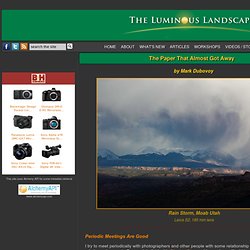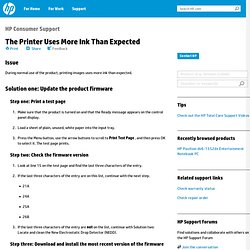

Slickrock. Printing papers are a matter of personal choice.

They are an aesthetic decisions, much as how to crop or whether to convert a colour image to monochrome. Some folks like it one way, some another. My taste in papers tends toward the simple, even classic types. I prefer papers that use Photo Black ink, because of the greater dMax (blacker blacks), and I like smooth but not too glossy surfaces. The traditional air dried F surface, in other words. On July 18, 2011 a new paper was announced by the Moab division of Legion Paper, and a few days later a sample box crossed my desk. Slickrock isn't the type of paper that would normally attract me. Sunday in The Park. Leica M9 with 50mm Summilux @ ISO 160 The surface has an ultra-smooth pearlescent finish with a metallic sheen. The so-called "Pearl" finish means that the paper has a semi-gloss – a sheen but without hard reflections. Of course Slickrock isn't the only metallic surface paper available.
Moab Slickrock = Solid. July, 2011. The Paper That Almost Got Away. Rain Storm, Moab Utah Leica S2, 180 mm lens Periodic Meetings Are Good I try to meet periodically with photographers and other people with some relationship to photography that I admire and respect.

One such individual is Charles Cramer. I have always liked his photographs and I have the highest respect for him not only as an artist, but also as a technician, an instructor and an individual. I had lunch with Charlie roughly three months ago and he brought some of his latest prints to show me. Why would I get palpitations over this name? The most beautiful multilayer Carbon Pigment Prints I have ever seen (including some of my own images) are printed using Arches Platine as the final substrate.
Could this be the mother load of all papers? Within less than an hour after lunch, I had placed an order for several boxes and rolls of this paper. Tree and Triangle Hill, Near Moab Utah Leica S2, 70 mm lens Description. Canson Infinity - ICC Profiles and Paper Presets. You can download from this page free ICC profiles and paper presets for each Canson Infinity papers and canvas, matched to the printers (using pigmented inks) most commonly used in the Digital Fine Art Market.

ICC profiles and paper presets will enable you to maximise the print quality and reproduce accurately the original colours, by calibrating the printer settings prior to printing. Because each paper has a slightly different shade, surface structure and reacts differently, it is important that use the setting that is specifically designed for this paper. The Printer Uses More Ink Than Expected HP Photosmart Pro B9180 Photo Printer. The NEDD monitors the printhead nozzles.

If the NEDD is dirty, the printer might spray ink into the sensor when attempting to clean the printheads. Follow these instructions to clean the NEDD manually. Step one: Locate the NEDD Make sure the product is turned on, then lift the lid.Press and hold the On button until the print carriage moves to the left.Locate the four spit and wipe sponges on the inside, right side of the product.Figure 1: Spit and wipe sponges and clean NEDD The NEDD is a 25.4 mm (1 inch) slot located to the left of the spit and wipe sponges.
Banding, Streaks, or Lines in the Printout HP Photosmart Pro B9180 Photo Printer. HP Photosmart Pro B9180. A Brief Industry History The photo-quality inkjet printer marketplace went though a revolution in the year 2000 when Epson brought out the Stylus 2000P.

This was the first affordable printer to use pigment-based inks. It was a flawed product, but it paved the way for subsequent generations of Epson pigment ink printers, currently culminating in the R2400, Stylus Pro 4800, 7800 and 9800, all of which use Epson's K3 third generation pigment ink set. Pigment inks offer a level of permanence not seen from printers which use dye-based inks. These actually exceed that of any colour reproduction process yet seen. Through several generations of printers, from consumer models to high end commercial versions, Epson has almost had the pigment ink market to itself for a number of years.
While Epson is to be commended for almost single-handedly inventing the fine-art photo printer market, it has stumbled badly from time to time. Hp9100Series : HP B9180 /9100 Series printers. HP B9180 Paper Impressions. I tried a lot of different paper for the HP B9180 printer and I’ve recorded my impressions here. The results should be the same for the HP B8850 which seems to be the same printer with no ethernet or LCD screen. A Note About Bronzing Gray-only inks on glossy paper are basically unusable from this printer. The composite gray option (or just printing a grayscale image in color mode) almost eliminates bronzing (except at very extreme angles), but isn’t quite as neutral. Before I got my printer profiled, I found that adding just a touch of sepia color to black and white images when printing in color mode often makes them look better (most people can’t even tell) and eliminates the perception of color cast (because the whole image is warm).
Spraying prints seems to solve the problem completely, and is probably a good idea anyway for people selling or displaying prints for a long time. Glossy Paper Most of the good-quality gloss papers feel and look are very similar. Recommended Acceptable.